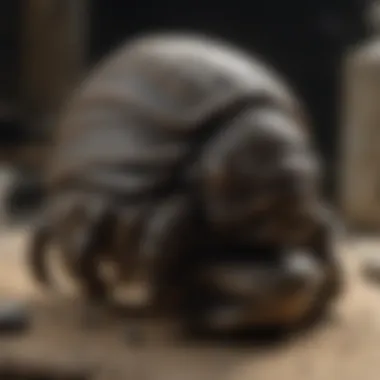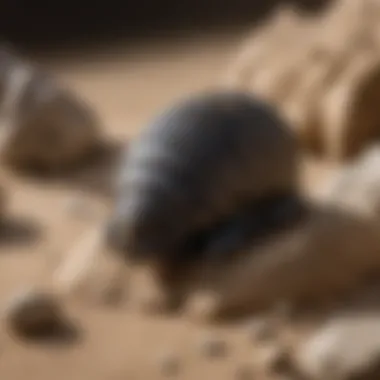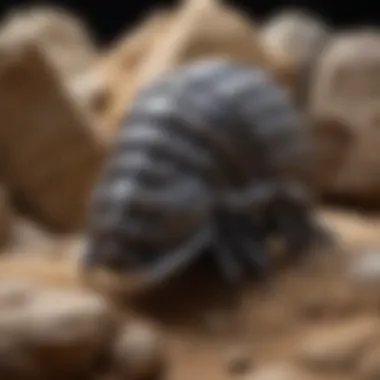Expert Guide to Acquiring Trilobite Fossils for Avid Collectors


Rock and Fossil Identification
Trilobite fossils are a captivating part of Earth's geological history, beloved by rock and fossil collectors for their intricate details and evolutionary significance. When identifying trilobite fossils, enthusiasts should familiarize themselves with the types of rocks and fossils commonly found in trilobite-rich regions. Sedimentary rocks, such as limestone and shale, often contain well-preserved trilobite specimens. Key characteristics to look for in trilobites include their segmented bodies, distinctive eye structures, and the presence of exoskeleton markings. Utilizing tools like magnifying glasses and UV lights can aid in the identification process, revealing finer details essential for distinguishing between different trilobite species.
Authenticity and Quality Assessment
Evaluating the authenticity and quality of trilobite fossils is crucial for collectors seeking valuable additions to their collections. Genuine trilobite fossils exhibit consistent characteristics, such as natural sedimentary encasement, intact appendages, and authentic coloration. It is essential to be wary of common indicators of forgery, such as artificial enhancement, unnatural poses, or mismatched preservation techniques. To ensure the authenticity of a trilobite fossil, collectors can consult with reputable experts, conduct thorough research on the specimen's provenance, and assess its overall preservation quality under scrutiny.
Sourcing Trilobite Fossils
When looking to purchase trilobite fossils, collectors should explore reputable sources, such as specialized fossil dealers, reputable museums, and verified online marketplaces. Thoroughly researching the seller's reputation, obtaining certification of authenticity, and clarifying return policies are essential steps to safeguard against purchasing counterfeit specimens. Additionally, attending fossil shows, exhibitions, and auctions can provide collectors with the opportunity to inspect trilobite fossils in person, assess their quality firsthand, and network with fellow enthusiasts and experts in the field.
Introduction to Trilobite Fossils
Trilobites, fascinating creatures from millennia past, hold a special place in the hearts of rock and fossil collectors worldwide. This section of the article serves as a captivating initiation into the realm of trilobite fossils, setting the stage for a deep dive into their significance and allure. Understanding the importance of trilobite fossils is not merely about acquisition but delving into a world where ancient marine life is preserved in stone. As we navigate through the intricate details of trilobites, enthusiasts will gain valuable insights into their evolutionary journey, unique characteristics, and remarkable significance in the field of paleontology.
Understanding Trilobites
- The Evolutionary History of Trilobites: When exploring the evolutionary history of trilobites, we unravel a tale of resilience and adaptation that spanned over millions of years. Trilobites, with their intricate exoskeletons and varied forms, provide a critical link to understanding prehistoric marine ecosystems. Their evolutionary success and diverse morphologies make them a focal point for collectors seeking a window into ancient life forms.
- Key Characteristics of Trilobites: Delving into the key characteristics of trilobites offers enthusiasts a glimpse into the remarkable features that set these creatures apart. From their segmented bodies to their complex eyes, trilobites exhibit a level of anatomical sophistication that showcases the intricacies of ancient marine biology. Understanding these distinct features enhances the appreciation of trilobite fossils as not just artifacts but windows into an ancient world.
- Significance in Paleontology: The significance of trilobites in paleontology cannot be overstated. These arthropods, existing for approximately 270 million years, play a vital role in studying ancient earth history and evolution. Their fossilized remains provide invaluable data for researchers, offering insights into past climates, geological events, and the evolution of life itself. Embracing the significance of trilobites in the broader context of paleontology enriches the pursuit of acquiring and understanding these ancient relics.
Factors to Consider When Buying Trilobite Fossils
When delving into the fascinating world of purchasing trilobite fossils, there are several crucial factors that rock and fossil collectors should consider. One of the primary elements to pay attention to is the authenticity and provenance of the fossil. Assessing the authenticity guarantees that collectors acquire genuine pieces, while understanding the provenance provides insight into the history and origin of the specimen, thus adding value and credibility to the purchase. Furthermore, considering the quality and preservation of the trilobite fossil is paramount. Evaluating the quality ensures that collectors acquire specimens in prime condition, free from damage or alterations that could diminish their worth. Preservation techniques play a significant role in maintaining the integrity and longevity of the fossils, making it essential to comprehend how these techniques impact the overall quality of the specimen. Lastly, being aware of market trends and pricing is crucial for making informed buying decisions. Understanding the factors that influence trilobite fossil prices, along with tips for navigating the fossil market and assessing value criteria, empowers collectors to make sound investments and expand their collections with confidence.
Where to Buy Trilobite Fossils
In the expansive world of trilobite fossil collecting, the aspect of where to buy these unique specimens holds significant importance. The accessibility to reliable sources plays a pivotal role in ensuring collectors acquire authentic and high-quality trilobite fossils for their collections. Understanding the avenues through which one can purchase these fossils is crucial for both seasoned enthusiasts and newcomers to the hobby.


Reputable Sellers and Dealers
Identifying Trustworthy Sources
Identifying trustworthy sellers and dealers in the field of trilobite fossils is a critical component of the buying process. Trustworthy sources are characterized by their reputation for selling authentic fossils with proper documentation and transparency. By choosing reputable sellers, collectors can minimize the risk of purchasing counterfeit or misrepresented specimens. Their adherence to ethical fossil trading practices enhances the overall credibility of the fossils being traded in the market.
Notable Fossil Retailers
Notable fossil retailers offer collectors access to a wide range of trilobite fossils, often accompanied by detailed information about each specimen. These retailers are distinguished by their curated collections, expertise in paleontology, and commitment to customer satisfaction. By purchasing from reputable retailers, collectors can expect a seamless buying experience, backed by reliable information and assurance of authenticity.
Online Platforms and Auctions
The rise of online platforms and auctions has revolutionized the way collectors can access trilobite fossils. These platforms provide a global marketplace for buyers and sellers to connect, offering a diverse selection of fossils from various regions. However, caution is advised when purchasing through online channels, as thorough research into the reputation of sellers and the authenticity of the fossils is crucial. Despite the convenience of online buying, collectors should exercise due diligence to ensure a secure transaction.
Local Rock and Fossil Shops
Benefits of Buying Locally
Purchasing trilobite fossils from local rock and fossil shops offers collectors the advantage of inspecting specimens in person before making a purchase. The tactile experience of viewing fossils up close allows for a more informed decision-making process. Additionally, buying locally supports small businesses within the community, contributing to the growth of the paleontological hobby at a grassroots level.
Networking with Local Collectors
Networking with local collectors provides a valuable opportunity to exchange knowledge, share experiences, and potentially discover hidden gems within the fossil collecting community. By engaging with fellow enthusiasts, collectors can expand their understanding of trilobites, learn about unique collection strategies, and foster connections that enhance their overall collecting journey.
Supporting Small Businesses
Supporting small businesses in the realm of rock and fossil collecting nurtures a sense of camaraderie within the community and helps sustain local enterprises dedicated to paleontology. Small businesses often offer personalized service, authentic expertise, and a deep passion for fossils, creating a more intimate buying environment for collectors. By choosing to support small businesses, collectors contribute to the preservation and promotion of the fossil heritage within their region.


Tips for Making an Informed Purchase
When it comes to purchasing trilobite fossils, being well-informed is key to making the right choices. This section delves into crucial aspects that every collector should consider before adding a trilobite fossil to their collection. By focusing on specific elements like authenticity, quality, and market trends, rock and fossil enthusiasts can ensure that their purchases are not only valuable but also meaningful.
Educate Yourself
Researching Trilobite Species
Researching trilobite species plays a vital role in discerning the rarity, historical significance, and authenticity of a fossil. Understanding the evolutionary trajectory, geographic distribution, and distinct features of various trilobites equips collectors with the knowledge needed to make informed decisions. By immersing oneself in the world of trilobites through research, collectors can appreciate the diversity and beauty encapsulated within each fossil specimen.
Understanding Fossil Terminology
Comprehending fossil terminology is essential for accurately describing, categorizing, and assessing trilobite fossils. Familiarity with terms related to anatomy, preservation methods, and geological contexts enables collectors to communicate effectively with sellers, experts, and fellow enthusiasts. This knowledge enhances the overall buying experience, ensuring that collectors are well-equipped to identify high-quality trilobite fossils.
Reading Reviews and Recommendations
Reviews and recommendations provide valuable insights into the reputation, reliability, and quality of sellers and dealers within the fossil market. By engaging with peer feedback, expert opinions, and industry recommendations, collectors can navigate the complexities of purchasing trilobite fossils with confidence. Leveraging the experiences of others enhances discernment, minimizes risks, and fosters a sense of community among fossil collectors.
Ask Questions and Seek Expert Advice
Clarifying Doubts with Sellers
Effective communication with sellers is instrumental in clarifying doubts regarding the authenticity, provenance, and value of trilobite fossils. By asking relevant questions, collectors can gain a deeper understanding of the specimen's history, condition, and significance. Establishing a dialogue with sellers promotes transparency and trust, fostering mutually beneficial transactions within the fossil collecting community.
Consulting with Fossil Experts
Consulting with fossil experts extends collectors' knowledge and enhances their decision-making process when acquiring trilobite fossils. Experts offer valuable insights, scientific perspectives, and authentication services that validate the authenticity and quality of fossil specimens. Collaborating with experts elevates the collecting experience, ensures accuracy in identification, and opens doors to rare and exceptional fossil finds.


Attending Fossil Shows and Events
Fossil shows and events provide unparalleled opportunities for collectors to engage with like-minded enthusiasts, discover new specimens, and learn from leading authorities in the field. By attending these gatherings, collectors can expand their networks, witness unique fossil exhibits, and acquire knowledge about the latest trends and discoveries in paleontology. Participation in fossil shows enriches the collecting journey, offering experiences that transcend mere acquisition and delve into a shared passion for prehistoric treasures.
Inspect the Fossil Thoroughly
Examining Details and Features
Thorough examination of a trilobite fossil involves scrutinizing its morphology, preservation quality, and any distinctive characteristics that contribute to its scientific and aesthetic value. By observing details such as eye placement, segmentation patterns, and shell texture, collectors can assess the authenticity and originality of the fossil specimen. A meticulous inspection reveals the true essence of the trilobite fossil, bringing to light its unique attributes and historical significance.
Checking for Restoration or Alteration
Detecting any signs of restoration or alteration in a trilobite fossil is essential for evaluating its integrity, value, and authenticity. Scrutinizing areas of repair, color enhancements, or surface modifications enables collectors to make informed judgments regarding the specimen's condition and historical accuracy. By ensuring that fossils remain unaltered and unadulterated, collectors uphold the preservation of scientific heritage and maintain the purity of their collections.
Requesting Additional Documentation
Requesting comprehensive documentation pertaining to a trilobite fossil, including provenance records, scientific analyses, and any relevant certificates, is imperative for establishing its legitimacy and historical context. Access to detailed information allows collectors to trace the fossil's journey, verify its origins, and validate its scientific significance. By acquiring thorough documentation, collectors elevate the value and authenticity of their fossil acquisitions, enriching their understanding of paleontological discoveries and contributing to the preservation of geological heritage.
Conclusion
In the realm of fossil collecting, the conclusion segment serves as a vital piece of the puzzle, drawing together the multitude of insights and guidelines provided throughout this comprehensive guide on purchasing trilobite fossils. It encapsulates the essence of informed decision-making and the amalgamation of factors crucial to enthusiasts. The significance of the Conclusion lies in its ability to empower rock and fossil collectors with the necessary acumen to navigate the intricate world of trilobite fossils with confidence.
Final Thoughts on Buying Trilobite Fossils
Summarizing Key Considerations
The section focusing on Summarizing Key Considerations acts as the cornerstone of the entire guide, distilling complex information into concise and actionable insights. By emphasizing key factors such as authenticity, preservation quality, and market trends, this aspect significantly enhances the reader's ability to make informed choices when purchasing trilobite fossils. Its inherent value lies in its ability to streamline decision-making processes, offering a structured approach to evaluating potential acquisitions.
Embracing the Joy of Collecting Fossils
Embracing the Joy of Collecting Fossils speaks to the heart of why individuals are drawn to the world of trilobite fossils in the first place. By underscoring the intrinsic satisfaction and emotional fulfillment that comes from building a collection, this segment highlights the deeper, more personal motivations behind fossil acquisition. It serves as a reminder that beyond the scientific and monetary aspects, true joy can be found in the appreciation and preservation of these ancient treasures.
Continuing Your Fossil Journey
The aspect of Continuing Your Fossil Journey propels collectors forward, urging them to see each acquisition as a stepping stone in their ongoing exploration of the fossil world. By emphasizing the notion of continuous learning, discovery, and growth, this segment encourages enthusiasts to delve deeper into the subject matter, expand their collection, and engage with the broader fossil community. It underscores the cyclical and enriching nature of fossil collecting, inviting individuals to embark on a lifelong odyssey of discovery and appreciation.







